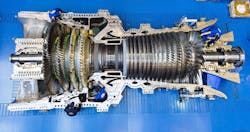Coming off its Minds + Machines Europe conference in Paris this week, GE’s executives headed a couple hours south to Bouchain, France, to commission what is now the world’s most efficient combined-cycle power plant. EDF Energy’s plant, equipped with GE’s HA turbine and officially started up today, has been recognized by Guinness World Records for its 62.22 percent efficiency.
It’s an accomplishment that has significant ramifications for EDF, not only for the power it can generate, but the space needed as well. The newly commissioned EDF plant is on 25 percent of the footprint of the old plant, and generates more power for 50 percent less carbon footprint, said Steve Bolze, president and CEO of GE Power.
That’s also good news for power plants facing increasing environmental regulations, especially as they work to support the recent Paris COP21 agreement, in which 195 countries pledged to reduce greenhouse gas emissions.
“We’re here to celebrate an important milestone today for power for the world, with the most efficient power plant ever installed in the world,” Bolze said. “It’s a new era of power generation technology and digital integration.”
A combined-cycle power plant already produces up to 50 percent more electricity than a traditional simple-cycle plant by routing waste heat from the gas turbine to an additional steam turbine, thereby generating more power. But gas turbine manufacturers are also making strides with their technology. The previous efficiency record from a combined-cycle power plant was just announced in January when Stadtwerke Düsseldorf in Germany achieved power-generating efficiency of 61.5 percent with a Siemens H-class gas turbine.
GE has been a pioneer in combined-cycle technology for many years, Bolze said, and the company’s HA turbine development has been part of a multibillion-dollar investment plan. GE expects to hit 65 percent efficiency by the end of the decade, said Joe Mastrangelo, president and CEO of GE’s Gas Power Systems. “As we look at the HA program and look forward to where we’re taking this, on march to produce better output, taking efficiency and continuing to drive it up,” he said. “62.22 is a beginning, not an ending for us.”
With a generating capability of more than 605 MW, EDF’s Bouchain plant will generate enough power to supply more than 680,000 homes. “By commissioning this new-generation thermal plant, EDF demonstrates its intent to apply the best available technologies on the market to make its French thermal power plants more energy-efficient while supporting the energy transition,” said Jean-Bernard Lévy, CEO of EDF.
In addition to the record efficiency levels, the HA gas turbine also delivers more flexibility, capable of reaching full power in less than 30 minutes. “This represents more opportunity to bring more renewables onto the grid,” Bolze said. The faster ramp to full load enables partners to respond quickly to fluctuations in grid demand, integrate renewables onto the grid and adapt quickly to weather changes.
“This is, I think, an incredible result,” said Umberto Dotta, deputy director of the thermal generation and engineering division for EDF, who said that GE and EDF co-invested in this plant as partners. “We’re obviously very proud of this partnership that dates back 45 years ago. It confirms EDF’s commitment to developing cutting-edge technologies.”
The Bouchain plant is also an important demonstration of GE’s Digital Power Plant capabilities, which use real-time data to deliver better plant outcomes with stable and efficient operations, while also providing predictive insights. GE will be maintaining and servicing the Bouchain plant for its duration, according to Paul McElhinney, president and CEO of GE’s Power Services, who pointed to the benefits of the Digital Power Plant. “Hundreds of sensors will allow for significant data capture,” he said. “Married with the Digital Plant, we will have significant inroads in avoiding unplanned downtime and in predictive maintenance.”
At the Minds + Machines event earlier in the week, GE Power unveiled the Digital Power Plant for Steam, a suite of technologies geared toward reducing greenhouse gas emissions by improving the performance and efficiency of coal-fired steam power plants. It’s a tough challenge given that plant technology is typically more mature (50 percent of active plants in Europe are more than 25 years old), systems are highly complex and average efficiency rates are low.
By monitoring and analyzing data from more than 10,000 sensor inputs across the plant, GE’s Digital Power Plant for Steam helps plant operators make decisions about how to optimally run their power plants, achieving better performance, greater efficiency and improved reliability while lowering environmental impact.
About the Author
Aaron Hand
Editor-in-Chief, ProFood World

Leaders relevant to this article:
